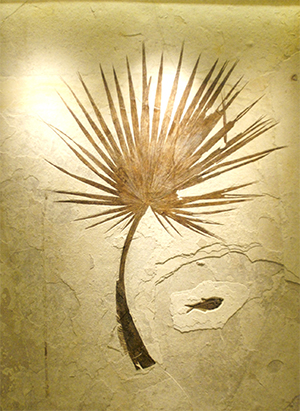Southwestern Wyoming, USA, probably from the Fossil Basin
Geologic Range:
Eocene Epoch (55-34 million years ago)
Approximate Age of Specimen:
50 million years old
Description:
Near the end of the Paleocene Epoch or beginning of the Eocene Epoch (60 to 45 million years ago), the Green River Lake System was formed in Wyoming, eastern Utah, and northwestern Colorado. This system consisted of three mostly freshwater lakes: Lake Uinta, Lake Gosiute, and Fossil Lake. This 245 cm (8 ft) tall by 181 (6 ft) wide slab, which contains a large palm frond and a herringlike fish, probably came from Fossil Lake. Fossil Lake lasted about 2 million years and, at 50 miles wide at its maximum, was the smallest of the three freshwater lakes. Thousands of other fossils, including more than 20 species of fish, have been recovered from the ancient bed of Fossil Lake.
The Eocene climate of the Fossil Lake area was subtropical, much like today's climate along the U.S. coast of the Gulf of Mexico. Palms, figs, cypress, and other semi-tropical plants thrived in the lowland valleys. Seasonal rainy periods may have induced frequent carbonate precipitations. The layers that formed from precipitated carbonate mud provided a protective cover for the bodies of fish and plants that had died and fallen to the bottom, and may have also contributed to the exquisite fossilization of the almost 188cm (6 ft) tall by 4 1/2 ft wide sabal palm (Sbalites sp.) frond that dominates this slab.
Nearly three hundred feet of mainly laminated micrite (microcrystalline carbonate rock) filled Fossil Lake and are exposed today as the Green River Formation. Although fossil specimens can be found throughout the widespread Green River Formation, most of the specimens collected are from the middle and upper parts of the formation. In locations beyond Fossil Lake, the shales of the Green River Formation are well known as "oil shales" because they hold waxy hydrocarbons called kerogen.
Diplomystus dentatus
The 22cm (9 inch) fish is commonly identified in Fossil Lake and was the largest herring genus. It can be distinguished by the presence and pattern of scale rows, or scutes, that lie along the midline of the back from the skull to the dorsal fin. The deep-bodied form and elongate anal fin are easily recognizable characteristics. The body form and the upturned mouth suggests that the fish fed on smaller surface-dwelling fish and/or insects.
